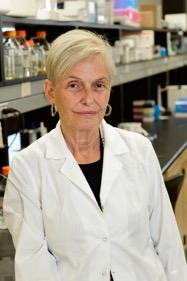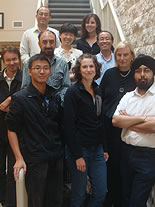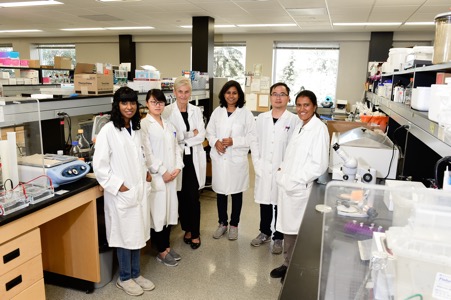
Dr. Jo-Anne Dillon PhD, FCAHS FRSC
Professor Biochemistry, Microbiology & Immunology- Address
- A218, VIDO
Research Area(s)
- Antimicrobial resistance, Cell division, Sexually transmitted infections, International health, Molecular technologies for microbial diagnostics
About
Dr. Dillon received a BSc from the University of Toronto and an MSc and PhD in Microbiology and Immunology from Queen’s University (Kingston, ON). She completed postdoctoral research with Dr Charles C. Briton Jr (Department of Biophysics and Microbiology, University of Pittsburgh) where she first began research on Neisseria gonorrhoeae.
Dr Dillon has held the following positions: Chief, Antimicrobials and Molecular Biology Division, Laboratory Centre for Disease Control, Health Canada; founding Chief, National Laboratory for Sexually Transmitted Diseases, Health Canada; Chair, Department of Microbiology and Immunology and Interim Chair, Adjunct Professor, Department of Biochemistry, Microbiology and Immunology (College of Medicine, University of Ottawa); Inaugural Director, Centre for Research in Biopharmaceuticals and Biotechnology, University of Ottawa; Dean, College of Arts and Science, University of Saskatchewan; and, Head, Department of Microbiology and Immunology, College of Medicine, University of Saskatchewan. She leads the World Health Organization endorsed Gonococcal Antimicrobial Surveillance Program in Latin America and the Caribbean. She has led several national and international organizations and has consulted widely on STIs and public health with national and international institutions. Dr Dillon has been awarded distinguished career awards by the Canadian Society of Microbiologists and the American Society for Microbiology. She is also a Fellow of the Royal Society of Canada and the Canadian Academy of Health Sciences.
Dr. Dillon will not be accepting additional graduate students in 2023.
RESEARCH INTERESTS
Our research has focused on sexually transmitted infections with emphasis on antimicrobial resistance and the biology of Neisseria gonorrhoeae.
1) Antimicrobial Resistance: Our laboratory has investigated antibiotic-resistance trends, molecular epidemiology and mechanisms of resistance, especially in N. gonorrhoeae, for over 30 years. Specific projects include:
- Antimicrobial surveillance, antibiotic resistance mechanisms and molecular epidemiology of N. gonorrhoeae (and other pathogens)
- Development of molecular and point of care test (POCT) approaches for diagnosing STIs and antimicrobial resistance.
- Developing a disruptive platform for the clinical characterization of sexually transmitted infections using Whole Genome Sequencing (WGS).
- As the focal point for the WHO-led Gonococcal Antimicrobial Susceptibility Program in Latin America and the Caribbean, we collaborate with many countries in the region to ascertain the antimicrobial susceptibility of N. gonorrhoeae isolates. This program started in 1990.
- Development of a pig model for studying N. gonorrhoeae pathogenesis (collaboration with Heather Wilson – http://vido.org/research/bacterial-vaccine-development/chlamydia-trachomatis)
2) Cell Division: Our laboratory pioneered the study of cell division in Neisseria gonorrhoeae. We identified and characterized the gene organization of both the division cell wall (dcw) cluster as well as the min cluster, which includes the min genes- minC, minD and minE, responsible for mid-cell site selection Using targeted mutagenesis to alter the structure we have been able to ascertain important functional domains on the Min proteins. We are currently investigating the cell division interactome of N. gonorrhoeae as well as the function of FtsI in cell division.
We also study cell division in Enterococcus faecalis. We identified a DivIVA homologue in Enterococcus faecalis, a bacterium that lacks Min proteins. DivIVA from E. faecalis is essential and plays important roles in chromosomal segregation. We are currently characterizing a novel DivIVA binding protein in E. faecalis.
Bacterial biology and antimicrobials
Laboratory address: Rm A233, 120 Veterinary Road Vaccine and Infectious Disease Organization University of Saskatchewan Saskatoon, SK S7N 5E3 Tel: (306) 966-1553
|
Current Lab members (from left August 2, 2017): Sumudu Perera, Cherry Wang, |
 |
| Current lab members (from left September 1, 2010): Front: G. Liu, A. Storey, J.R. Dillon, R. Parti. Middle: S. Vidovic, A. Havaei, Y. Li, M. Liao. Back: S. Dev, S. Starnino. |
Laboratory members:
Recent Publications
- M. Unemo, H. Seifert, E. Hook, S. Hawkes, F. Ndowa, and J.R. Dillon. 2019. Gonorrhoea. Nature Reviews Disease Primers. NRDP-18-112V1B. Accepted for publication (Sept 12 2019)
- J. Shi, Y Yan, M.G. Links, L. Li, J.R. Dillon, M. Horsch, and A Kusalik. 2019. Antimicrobial resistance genetic factor identification from whole genome sequence data using deep feature selection. BMC Bioinf-D-19-00884. In Press. Accepted August 23 2019.
- M. Unemo, M.M. Lahra, M. Cole, P. Galarza, F. Ndowa, I. Martin, J.R. Dillon, P. Ramon-Pardo, G. Bolan and T. Wi. 2019. World Health Organization Global Antimicrobial Surveillance Program (WHO GASP): review of new data and evidence to inform international collaborative actions and research efforts. Sex Hth. Aug 23. Doi:10.1071/SH19023.
- R. Singh*, S.R. Perera*, P. Chumala, G.S. Katselis, I. Martin, A. Kusalik, K.M. Mitzel, and J.R. Dillon. 2019. A β- lactamase-producing plasmid from Neisseria gonorrhoeae carries a unique 6 bp deletion in blaTEM-1 encoding truncated 24KD TEM-1 penicillinase that hydrolyzes ampicillin slowly. Under revision. J Antimicrob Chemother. Jul 23. pii:dkz306. Doi: 10.1093/jac/dkz306 (*equal contribution).
- S.D. Thakur, M. Obradovis, J.R. Dillon, S.H. Ng, and H.L. Wilson. 2019. Development of flow cytometry based adherence assay for Neisseria gonorrhoeae using 5'-carboxyfluorosceinsuccidyl ester. BMC Microbiol. Mar 25;19(1):67. doi: 10.1186/s12866-019-1438-2
- R Singh, J.R. Dillon, W. Demczuk, A. Kusalik. 2019. Gen2Epi: an automated whole genome sequencing pipeline for linking full genomes to antimicrobial susceptibility and molecular epidemiological data in Neisseria gonorrhoeae. BMC Genomics Mar 4 20(1):165 (JRD and AK contributed equally as senior authors of this publication).
- A.D. Cristillo, C.C. Bristow, E. Torrone, J.R. Dillon, R.D. Kirkaldy, H. Dong, Y.H. Grad, R.A. Picholas, P.A. Rice, K. Lawrence, D. Oldach, W.M. Shafer, P. Zhou, T.E. Wei, S.R. Morris, and J.D. Klausner. 2019. Review. Antimicrobial resistance in Neisseria gonorrhoeae: proceedings of the STAR sexually transmitted infection- clinical trial group programmatic meeting. Sexually Transmitted Diseases. Sex Transm Dis. 2019 Mar;46(3):e18- e25. doi: 10.1097/OLQ.0000000000000929.
- S.D. Thakur, M. Obradovis, J.R. Dillon, S.H. Ng, and H.L. Wilson. 2019. Development of flow cytometry based adherence assay for Neisseria gonorrhoeae using 5'-carboxyfluorosceinsuccidyl ester. BMC Microbiol. Mar 25;19(1):67. doi: 10.1186/s12866-019-1438-2
- R. Singh*, S.R. Perera*, P. Chumala, G.S. Katselis, I. Martin, A. Kusalik, K.M. Mitzel, and J.R. Dillon. 2019. A β- lactamase-producing plasmid from Neisseria gonorrhoeae carries a unique 6 bp deletion in blaTEM-1 encoding truncated 24KD TEM-1 penicillinase that hydrolyzes ampicillin slowly. Under revision. J Antimicrob Chemother. Jul 23. pii:dkz306. Doi: 10.1093/jac/dkz306 (*equal contribution).
- J. Pillay, A. Moore, P. Rahman, G. Lewin, D. Reynolds, J. Riva, G. Theriault, B. Thombs, B. Wilson, J. Robinson, A. Ramdyal, G. Cadieux, R Featherstone, A.N. Burchell, J. Dillon, A. Singh, T. Wong, M. Doull, G. Traversy, S. Courage, T. MacGregor, C. Johnson, B. Vandermeer, L. Hartling. 2018. Screening for chlamydia and/or gonorrhea in primary health care: protocol for systematic review. Systematic Reviews. 7(1):248- 266.
- S.R. Perera, A. Taheri, N.H. Khan, R.P. Parti, S. Stefura, P. Skiba, J.P. Acker, I. Martin, A. Kusalik and J.R. Dillon. 2018. Evaluation of a hydrogel-based diagnostic appraoach for the point-of-care based detection of Neisseria gonorrhoeae. Antibiotics. 7:0070. Doi: 10.3390/antibiotics7030070.
- S. D. Thakur, P.N. Levett, G.B. Horsman, and J.R. Dillon. 2018. Association of Neisseria gonorrhoeae genogroups and specific PBP2/MtrR/PorB mutation patterns with susceptibility to penicillin in a susceptible gonococcal population. J Antimicrob Chemother. Jul 9 Doi:10.1093/jac/dky233.
- P. Sawatzky, I. Martin, P. Galarza, M.E. Trigoso, P. Araya Rodrigue, O.M. Sanabria, A. Llop Hernandez, M.F. Martinez, G. Borthagaray, D. Payares, J.E. Moreno, M. Chiappe, A.H. Corredor, S. Dev Thakur and J.R. Dillon. 2018. Quality assurance for antimicrobial susceptibility testing of Neisseria gonorrhoeae in Latin American and Caribbean countries 2013-2015. Sex Trans Infect. 45(5):316-318. doi: 10.1136/sextrans-2017-053502.
- S.D. Thakur, N.R. Parmar and J.R. Dillon. 2018. Time to develop standardized molecular diagnostics for the simultaneous detection of Neisseria gonorrhoeae and its antimicrobial resistance. Sex. Trans. Dis. 45(5):316- 318. doi: 10.1097/OLQ.0000000000000834.
- S. Dev Thakur, P.N. Levett, G.B. Horsman and J.R. Dillon. 2018. High levels of susceptibility to new and older antibiotics in Neisseria gonborrhoeae isolates from Saskatchewan (2003-15): time to consider point-of-care or molecular testing for precision treatment? – authors’response. J Antimicrob Chemother doi:10.1093/jac/dkx512.
- S Dev Thakur and J.R. Dillon. 2018. Suitability of a chocolate agar-based medium for the transportation and long term storage of Neisseria gonorrhoeae isolates at room temperature. J. Microbiol Methods. 144 (1): 86- 87.
- S.D. Thakur, P.N. Levett, G.B. Horsman, and J.R. Dillon. 2018. High levels of susceptibility to new and older antibiotics in Neisseria gonorrhoeae isolates from Saskatchewan (2003-2015): time to consider point of care or molecular testing for precision treatment? J Antimicrob Chemoth. 73:118-125. Doi:10.1093/jac/dkx333.
- Y. Zou, Y. Li and J.R. Dillon. 2017. The distinctive cell division interactome of Neisseria gonorrhoeae. BMC Microbiol. Dec 12, 17(10:232.doi:10.1186/s12866-107-1140-1.
- T. Kaiser, F. Renois, H.L. Wilson, T. Cnudde, V. Gerdts, J.R. Dillon, G. Jungersen, J.S. Agerholm, and F. Meurens. 2017. Contribution of the swine model in the study of human secually transmitted infections. Infect Genet Evol. Nov 23 pii:S1567-1348(17)30402-1. https://doi.org/10.1016/j.meegid.2017.11.022.
- Perera SR, Khan NH, Martin I, Taheri A, Parti RP, Levett PN, Horsman GB, Kusalik A, Dillon JR (2017). A Multiplex RT-PCR Assay for the Simultaneous Identification of Neisseria gonorrhoeae and its Ciprofloxacin Susceptibility Status. Journal of Clinical Microbiology. Doi:10.1128/jcm.00855-17.
- E. Alirol. T.E. Wi, M. Bala, M. L. Bazzo, X-S Chen, C. Deal,J.R. Dillon, R.Kularatne, J. Heim, R. Hoft van Hurjsduijnen, E.W. Hook, M.M. Lahra, D.A. Lewis, F. Ndowa, W.M. Shafer, L. Tayler, K. Workowski, M. Unemo and M. Balasegaram (2017). Multi-drug-resistant gonorrhea: a research and development road map to discover new medicines. PLOS Medicine 14(7):e1002366.
- Y. Zou, Y Li, and J.R. Dillon (2017). An Escherichia coli expression model reveals the species-specific function of FtsA from Neisseria gonorrhoeae in cell division. FEMS Microbiol Lett. May 1;364 (9). doi: 10.1093/femsle/fnx078
- M.A. Trecker, J.R. Dillon, K. Lloyd, M. Hennink, A. Jolly and C. Waldner (2017). Can Social network analysis help address the high rates of bacterial sexually transmitted infections in Saskatchewan. Sex Trans Dis. 66(6):338-343.
- W. Demezuk, S. Sidhu, M. Unemo, D.M. Whiley, V.G. Allen, J.R. Dillon, M. Cole, C. Seah, E. Trembizki, D.L. Trees, E.N. Kersh, A.J. Abrams, H.J.C. de Vries, A.P. van Dam, I. Medina, A. Bharat, M.R. Mulvey, G. Van Domselaar, and I. Martin (2017). Neisseria gonorrhoeae sequence typing for antimicrobial resistance (NG-STAR): a novel antimicrobial multilocus typing scheme for tracking the global dissemination of N. gonorrhoeae strains. J Clin Microbiol. 55(5):1454-1468.
- S.D. Thakur, P. Araya, G. Borthagaray, P. Galarza, A Llop Hernandez, D. Payares, O.M. Sanabria Cruz, M.E. Trigoso Carvallo, A.H. Corredor, and J.R. Dillon (2017). Resistance to ceftriaxone and azithromycin in Neisseria gonorrhoeae from 7 countries of South America and the Caribbean: 2010-2011. Sex Transm Dis 44(3):175-160.
- T. Kaser, J.A. Pasternak, M. Delgado-Ortega, G. Harmonic, K. Lai, J. Erikson, S. Walker, J.R. Dillon, V. Gerdts, and F. Meurens (2017). Chlamydia suis and Chlamydia trachomatis induce multifunctional CD4 T cells in pigs. Vaccine 35(1): 91-100.
- T. Wi, M.M. Lahra, F. Ndowa, M. Bala, J.R. Dillon, P. Ramon-Pardo, S.R. Eremin, G. Bolan , and M. Unemo M. 2017. Antimicrobial resistance in Neisseria gonorrhoeae: Global surveillance and a call for international collaborative action. PLoS Med. 2017 Jul 7;14(7):e1002344. doi: 10.1371/journal.pmed.1002344. eCollection July 7 2017.
- M.M. Lahra, J.R. Dillon, C.R.R. George, D.A. Lewis, T.E. Wi and D.M. Whiley (2016). From zero to zero in 100 years: gonococcal antimicrobial resistance. Microbiol Austral. 10.1071/MA16058.
- P. Sawatsky, G. Liu, J.R. Dillon, V. Allen, B. Lefebvre, L. Hoang, G. Tyrrell, P. Van Caeseele, P. Levett, and I. Martin (2015). Quality Assurance for antimicrobial susceptibility testing of Neisseria gonorrhoeae in Canada: 2003-2012. J Clin Microbiol. Nov,53 (11):3646-364
- J.R. Dillon, R. Parti, and S. D. Thakur (2015). Invited review article. Antibiotic resistance in Neisseria gonorrhoeae isolates: Will infections be untreatable in the future? Invited review article. Culture. 35(1):1-8.
- G.Q. Liu, R.P. Parti, and J.R. Dillon. 2015. Suppression or ERK activation in urethral epithelial cells infected with Neisseria gonorrhoeae and its isogenic minD mutant contributes to anti-apoptosis. Microbes and Infection. Apr, 17(4):317-322. doi: 10.1016/j.micinf.2014.12.012. Epub 2014 Dec 29.PMID:25554485
- M.N.Ezewudo, S.J. Joseph, S. Castillo-Ramirez, D. Dean, C. del Rio, X Didelot, J. R. Dillon, R.F. Selden, W.M. Shafer, R.S. Turingan, M. Unemo, and T.D. Read. 2015. Population structure of Neisseria gonorrhoeae based on whole genome data and its relationship with antibiotic resistance. PeerJ mar5.3:e806. Doi 10.7717/peerj.806. ecollection 2015. 23 pages
- M. Trecker, J.R. Dillon, K. Lloyd, M. Henninck, and C. Waldner. 2015. Demographic and behavioural characteristics predict bacterial STI reinfection and coinfection among a cross-sectional sample of laboratory confirmed gonorrhea cases in a local health region from Saskatchewan, Canada. Can J Publ Hlth . 106(2)e17-21. Doi 10.17269/rcsp 106.4792.

